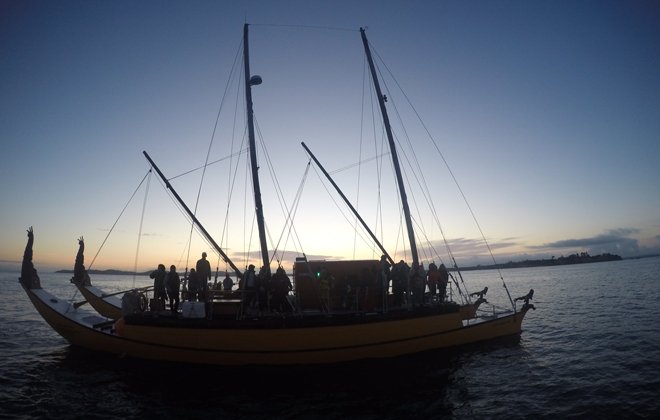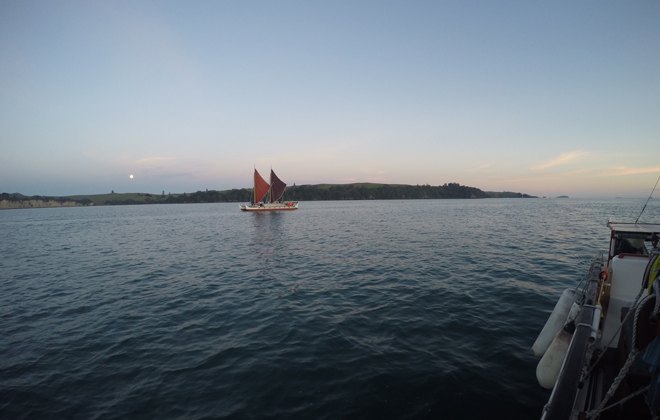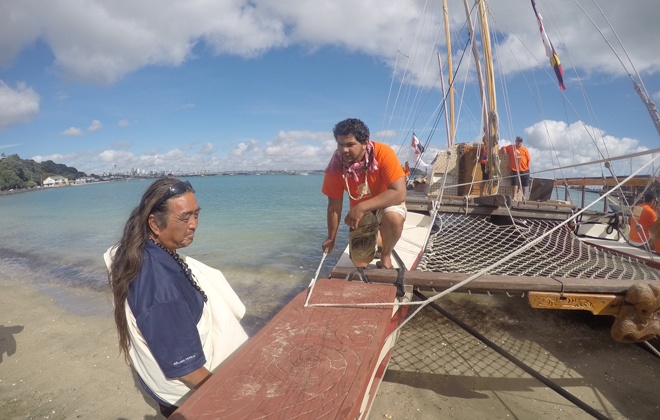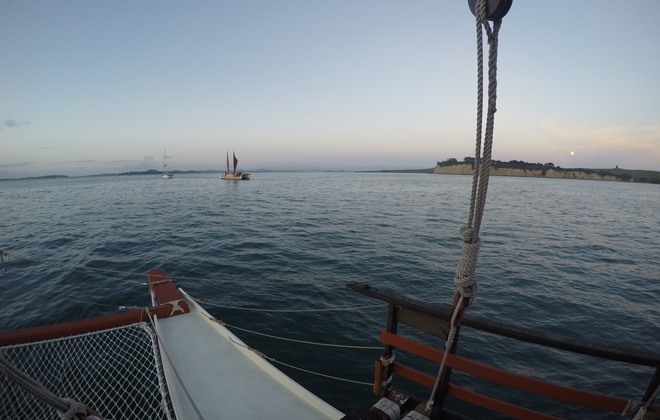Hōkūle‘a, Hikianalia meet other voyaging canoes in Auckland













AUCKLAND, NEW ZEALAND » As hundreds of onlookers watched from shore, six Pacific canoes converged Sunday for a rare beachside reunion to celebrate how far they’ve come and to honor Hokule’a, the Hawaiian vessel that started their push to keep ancient voyaging practices alive.
These traditional double-hulled canoes from the Cook Islands, New Zealand and Hawaii met in a scenic coastal region named by its early Maori inhabitants as “The Gathering Place of the Canoes” (Tamaki Herenga Waka) — and coincidence brought them all together in one aptly named place.
Crews returning from a voyage Australia happened to be sailing into New Zealand not long after Hokule’a and its escort canoe, Hikianalia had arrived in their latest stop of an epic but risky around-the-world sail, dubbed Malama Honua (“Care for our Earth”).
“It just settled in my bones that we’re all part of a whole,” Jenny Mauger, a crew member of New Zealand-based voyaging canoe Haunui, said of Sunday’s gathering. The reunion included dozens of crews and six pwo (master) navigators — experts and teachers in the art of wayfinding that nearly disappeared several decades ago.
“Finally, here we all are as family — not as separate canoes but as one,” Mauger said.
Along with Haunui, Hokule’a and Hikianalia were joined by New Zealand-based canoes Hine Moana and Aotearoa One, as well as Cook Island-based canoe Marumaru Atua.
Don't miss out on what's happening!
Stay in touch with breaking news, as it happens, conveniently in your email inbox. It's FREE!
Haunui and Marumaru Atua along with two other canoes, Samoa-based Gaualofa and Fiji-based Utonialo had just made landfall in their return from the sail to Sydney, Australia to raise awareness of the ecological issues that the oceans face during the International Union for Conservation of Nature’s World Parks Congress held there.
The Samoa and Fiji canoes didn’t arrive down the New Zealand coast in time for the reunion, but their crews did attend some of the festivities later in the day.
Dozens of international voyagers also seized the moment to salute Hokule’a, anchored not far from where several of the canoes came up on the beach in Auckland’s Okahu Bay. The Hawaiian vessel, which kicked off this Pacific-wide revival of voyaging and navigating with the stars and swells, will leave the Pacific next year for the first time in its nearly 40-year existence.
Hokule’a is a household name across Hawaii, and it’s become synonymous with voyaging across much of the state and elsewhere. However, this event nearly 5,000 miles from Hawaii showed just how active and widespread voyaging has become across the Pacific following Hokule’a’s example. Captains and crews on all of the other canoes could either directly or indirectly trace their start in voyaging back to Hokule’a.
“She’s the icon of Pacific-island existence,” said Tua Pittman, a Cook Islander and pwo (master) navigator who got his start in voyaging by crewing Hokule’a in 1986. He also leads the Cook Islands Voyaging Society. “If they hadn’t jumped on Hokule’a and sailed back to Tahiti (in 1976), we wouldn’t be doing what we’re doing now,” Pittman said.
When Hokule’a first pushed off the shore at Kualoa in 1975, it was one of maybe several long-distance canoes in the Pacific — and the only one created to use non-instrumentation navigation.
Since then, it’s helped lead to the creation of 16 or so similar voyaging canoes around the Pacific, each supported by local sailing societies and foundations to trek around the Ocean.

The day was significant for Hikianalia, too. It reunited the escort vessel with three “sister” canoes built from the same mold, part of an eight-vessel fleet created by a philanthropic foundation looking to promote cleaner, more environmentally friendly watercraft for the future.
The concept, Okeanos Foundation head and underwater filmmaker Dieter Paulmann explained, was to take the successful canoe designs that Polynesians perfected hundreds of years ago and combine them with modern, clean energy sources of wind and sun.
Most of the canoes were built in 2009 ahead of a pan-Pacific voyage, dubbed Te Mana O Te Moana (“The Spirit of the Ocean”). After the voyage ended, Okeanos donated to voyaging societies in Fiji, Tahiti, Samoa, and the Cook Islands one canoe each from the fleet, Paulmann said.
All eight sailing canoes can also fall back on electric-powered motors to propel them quietly for relatively short distances. They share the same design, but their crews have customized and decorated each craft different. The idea was to get as many islands involved as possible, he said.
These voyaging societies emerged in the past several decades following Hokule’a’s earliest voyages.
They also occasionally look to share Voyaging crew members. When Marumaru Atua first tied onto its sister canoe Hikianalia while both were anchored outside Auckland on Friday, the Cook Island-based vessel included Waimea, Hawaii natives Kala Thomas and Lei’ohu Santos-Colburn as crew.
The two Hawaii Island natives had sailed on a previous leg of the Malama Honua voyage with the pwo navigators currently aboard Marumaru — Pittman and his fellow Cook Islander, Peia Patai.
Thomas said he’s really enjoyed the experience so far. These younger societies, he said, offer those from Hawaii a chance to do more long-distance voyaging. The well-established Oahu-based Polynesian Voyaging Society already sees huge demand from volunteers looking to crew its canoes.
“You have a spot on the canoe,” Thomas said of the other societies Sunday. “This is a part of our life. We’re going to do this for the rest of our lives in some capacity,” Thomas added, referring to himself and Santos-Colburn. “Seize the opportunities when they present themselves. You’ve got to take them.”
Some of the crews come from places around the globe, including Sweden, Italy and Malaysia.
“I hope to inspire the people back home. People in Malaysia have a serious pollution problem,” said Malaysia native and Haunui crew member Mohiyuddin Gilani. The nation frequently sees fishermen detonate dynamite in coral-filled waters, he said. “When you live on the waka (canoe), you live on an island and you have to take care of your resources. I think this is a good step to learn from our Pacific cousins.”
Sunday’s events featured a traditional “powhiri” ceremony with Maori leaders from around the country and a greeting from Auckland’s Mayor, Len Brown, at Waitemata Harbor in the heart of the city.
“The voyaging isn’t just about sailing. This voyage, Malama Honua … Is about the Pacific islands having a voice, and recognizing the validity of ancient wisdom,” Polynesian Voyaging Society Vice President Bruce Blankenfeld told the Maori elders and guests during the powhiri. “We weren’t just surviving on islands, we were flourishing on islands.”
Hokule’a and Hikianalia crews will spend the next several days painstakingly cleaning and unloading the canoes of food and supplies before flying home ahead of the holidays. A new crew will arrive in several weeks. The canoes will spend the next five months or so in New Zealand, making repairs and waiting out the hurricane season before the worldwide voyage resumes.







